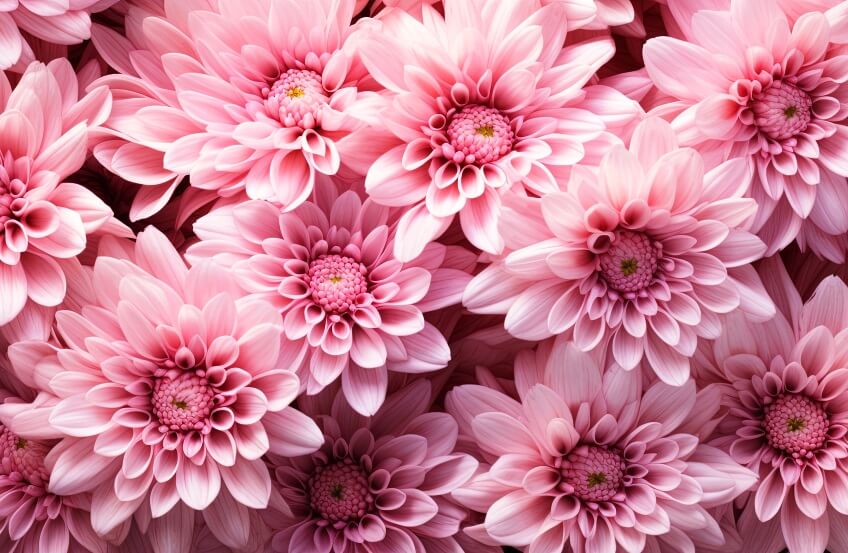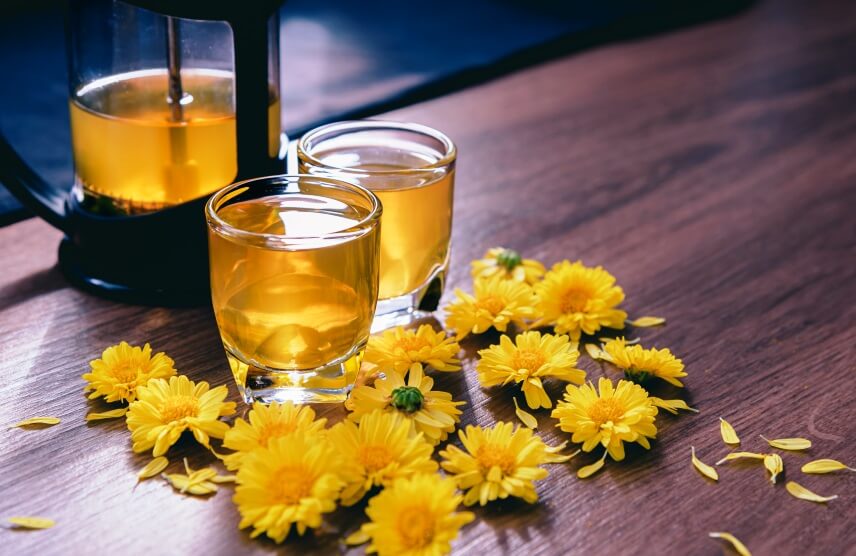Chrysanthemums (Chrysanthemum spp.) with their vibrant colors and diverse forms, are more than just ornamental flowers. Cultivated for centuries in Asia, particularly China, they hold a special place in traditional medicine and are gaining recognition for their potential health benefits. This Article explores the world of chrysanthemums, assessing their characteristics and applications, the advantages associated with chrysanthemum tea, and some considerations for consumption.
If you are interested in this topic, you can also read
<<Coriander Seeds Benefits >> and <<Benefits Of Burning Bay Leaf >> articles.
Nutritional Content Of Chrysanthemums
While not typically consumed in large quantities, chrysanthemums offer a modest amount of essential nutrients. Here is a breakdown of some key components:
- Vitamins: Chrysanthemums contain small amounts of vitamins, including Vitamin A (through beta-carotene), B vitamins like choline, folic acid, and riboflavin, as well as Vitamin C.
Table 1. Chrysanthemum petals composition (%)
| Components | Chrysanthemum boreale / morifolium |
|---|---|
| Moisture | 11.7 / 11.0 |
| Crude protein | 6.1 / 11.7 |
| Crude fat | 2.7 / 2.6 |
| Crude ash | 3.7 / 5.2 |
| Reducing sugar | 11.1 / 12.8 |
| Crude fiber | 9.8 / 9.1 |
| Minerals (mg/g dry weight) | |
| Potassium | 67.72 / 64.64 |
| Calcium | 558.90 / 242.68 |
| Sodium | 14.28 / 19.68 |
| Magnesium | 15.69 / 17.56 |
| Zinc | 3.69 / 8.24 |
| Manganese | 2.19 / 3.24 |
| Ferro | 44.51 / 13.72 |
| Copper | 1.28 / 1.41 |
It is important to note that the exact nutritional content of chrysanthemums can vary depending on the species, growing conditions, and how they are prepared.
Chrysanthemum Health Benefits
Chrysanthemum tea, brewed from the plant’s dried flowers, offers a more concentrated source of some nutrients than the whole flower. As a result, this section takes a closer look at the benefits of chrysanthemum tea.
Benefits of Chrysanthemum Tea
Chrysanthemum tea, steeped in tradition, offers a range of potential health benefits. From its historical use in Chinese medicine to growing scientific exploration, here are some key areas where chrysanthemum tea might be advantageous:
Low in Calories
A typical cup of chrysanthemum tea is very low in calories, usually containing around 12 calories per serving.
Minerals
Chrysanthemum tea is a good source of potassium, which is vital for maintaining proper muscle and nerve function. Smaller amounts of other minerals, like magnesium, calcium, and iron, might also be present.
Antioxidant Powerhouse
Chrysanthemum tea is brimming with antioxidants, which can help combat free radical damage in the body, potentially reducing the risk of chronic diseases [1, 2].
Immune System Ally
Vitamin C and other essential minerals in chrysanthemum tea might contribute to a stronger immune system, aiding the body in fighting off infections [3, 4].
Promoting Relaxation
Chrysanthemum tea is known for its calming properties. It may help lower blood pressure and reduce inflammation, promoting relaxation and potentially improving sleep quality [5, 6].
Cold And Flu Relief
Traditionally, chrysanthemum tea has been used to alleviate cold and flu symptoms, such as fever, sore throat, and congestion [7].
Heart Health Support
Studies suggest chrysanthemum tea may contribute to lowering blood pressure and cholesterol levels, potentially benefiting heart health [8, 9].
Skin Soothing Properties
The anti-inflammatory properties of chrysanthemum tea, along with its potential antibacterial effects, might be beneficial for skin conditions like eczema and psoriasis [10].
Important Considerations
While chrysanthemum tea appears to be safe for most people in moderation, there are some factors to keep in mind:
- Limited Scientific Evidence: While some studies exist, more scientific research is needed to confirm the health benefits of chrysanthemum tea definitively.
- Preparation Method: The brewing method and the amount of chrysanthemum flowers used can affect the final nutrient content of the tea.
- Potential Drug Interactions: Chrysanthemum tea may interact with certain medications. It is crucial to consult with a healthcare professional before consuming chrysanthemum tea, especially if taking medication.
- Pregnancy And Breastfeeding: Pregnant and breastfeeding women should consult with a doctor before consuming chrysanthemum tea due to a lack of sufficient safety data.
Chrysanthemum (Tea) Benefits For Female
Here, we explore the potential health benefits of chrysanthemums and chrysanthemum tea, specifically for women. It is important to remember that more research is needed to confirm these benefits.
Menstrual Health
Traditionally, chrysanthemum tea has been used to alleviate menstrual cramps and discomfort. While the exact mechanism is not fully understood, its anti-inflammatory properties might be a contributing factor [11, 12].
Chrysanthemum (Tea) Side Effects
Like many herbs, chrysanthemum and chrysanthemum tea have some potential side effects.
Allergic Reactions
People with allergies to ragweed, daisies, marigolds, or other plants in the Asteraceae family might experience allergic reactions to chrysanthemums. In rare cases, symptoms can include skin rashes, swelling, itching, or even anaphylaxis [13].
Sun Sensitivity
Chrysanthemum tea may increase sun sensitivity. If you consume chrysanthemum tea regularly, it is crucial to wear sunscreen, especially if you have light skin [14].
Drug Interactions
Chrysanthemum tea might interact with certain medications. For instance, it might interact with statins used to lower cholesterol. Consult with a healthcare professional before consuming chrysanthemum tea if you take any medications [15].
How To Make Chrysanthemum Tea?
In this section, you can find the simple steps involved in brewing a perfect cup of chrysanthemum tea, allowing you to experience its calming properties and subtle taste [16].
Ingredients
- Dried chrysanthemum flowers (approximately 1-2 tablespoons)
- Water
- Optional: Honey, rock sugar, or other natural sweetener (to taste)
Utensils
- Teapot or heat-resistant mug
- Strainer or cheesecloth (optional)
- Kettle
Instructions
- Measure the Flowers: Begin by measuring out 1-2 tablespoons of dried chrysanthemum flowers. The amount can be adjusted based on your desired strength.
- Heat the Water: Fill your kettle with water and bring it to a boil.
- Steep the Flowers: Place the measured chrysanthemum flowers in your teapot or mug. Once the water reaches a boiling point, pour it over the flowers.
- Steeping Time: Cover your teapot or mug and allow the chrysanthemum flowers to steep for 3-5 minutes. For a stronger flavor, you can steep it for up to 10 minutes.
- Strain (Optional): If using loose chrysanthemum flowers, strain the tea into a cup using a strainer or cheesecloth to remove the flower petals. This step is optional, and you can enjoy the tea with the petals if preferred.
- Sweeten (Optional): If desired, add a touch of honey, rock sugar, or another natural sweetener to enhance the taste.
- Enjoy! Sit back, relax, and savor your cup of fragrant chrysanthemum tea.
Tips
- Fresh vs. Dried Flowers: Fresh chrysanthemum flowers can be used for tea, but you will need a larger quantity (around 4-6 flowers) compared to dried flowers. The steeping time for fresh flowers might also be shorter, around 2-3 minutes.
- Multiple Infusions: Dried chrysanthemum flowers can often be steeped multiple times. After the first steeping, simply add hot water again and let it steep for another 3-5 minutes.
- Storage: Store your dried chrysanthemum flowers in an airtight container in a cool, dark place to preserve their freshness and aroma.
How To Eat Chrysanthemum Flower?
Chrysanthemums hold a surprising culinary potential, especially in certain cultures. You can enjoy chrysanthemum flowers not just as a tea, but as a delightful and nutritious addition to your meals [17,18].
Edible Varieties
It is important to note that not all chrysanthemums are edible. Species specifically cultivated for culinary purposes are preferred. Some popular edible varieties include:
Crown Daisy (Chrysanthemum coronarium): This variety has ferny green leaves and yellow or white flower heads.
Garland Chrysanthemum (Chrysanthemum morifolium): This type boasts large, showy flowers in various colors and is commonly used in Asian cuisine.
Shungiku (Chrysanthemum coronarium var. spatiosum): This Japanese variety has a distinctive bitter flavor and is often enjoyed blanched or tempura-fried.
Eating Chrysanthemum Petals
Here are some ways to incorporate chrysanthemum petals into your culinary creations:
Salads: Fresh chrysanthemum petals, with their peppery or slightly bitter taste, can add a unique textural and flavor contrast to salads. Use the young, tender petals for the best experience.
Garnishes: The vibrant colors and delicate shape of chrysanthemum petals make them a beautiful and edible garnish for various dishes.
Stir-fries: Briefly blanch or stir-fry edible chrysanthemum petals or leaves to add a pop of color, flavor, and nutrients to your stir-fries.
Tempura: Tempura-frying chrysanthemum flowers is a popular method in Japanese cuisine. The batter creates a light and crispy texture, contrasting with the flower’s slightly bitter flavor.
Pickles: Pickled chrysanthemum petals are a traditional Korean dish known for their tangy and slightly spicy flavor.
Before You Eat
Here are some crucial points to consider before consuming chrysanthemum flowers:
Source: Ensure you’re using chrysanthemums specifically grown for culinary purposes. Flowers treated with pesticides or herbicides are not safe for consumption.
Taste: Chrysanthemum flowers can have a slightly bitter or peppery taste. Start with a small amount to assess your preference.
Cooking Method: Depending on the chosen method (salad, stir-fry, etc.), adjust the cooking time to retain the flower’s texture and avoid overcooking.
Using Chrysanthemum Flower Petals As A Dye
Beyond their captivating beauty, chrysanthemums hold a hidden talent—the ability to dye textiles. The use of chrysanthemum flowers as a dye has a rich history, particularly in Asia. In China, evidence suggests chrysanthemum dye has been employed for centuries, gracing textiles with vibrant yellows and oranges. Japan also embraced this natural dye, utilizing it for silk garments like kimonos [19, 20, 21].
Colors From The Petals
Chrysanthemum flowers yield a range of colors depending on the variety and the extraction process. Here is a glimpse into the color palette:
Yellows and Oranges: These vibrant hues are the most commonly obtained colors from chrysanthemum flowers.
Reds and Pinks: While less frequent, some specific chrysanthemum varieties can produce reddish or pinkish tones in the dye.
Natural Dyeing Process
The process of using chrysanthemum flowers as a dye involves several steps:
- Flower Selection: Selecting the right chrysanthemum variety is crucial. Species with high pigment content will yield stronger dyes.
- Petal Preparation: The petals are typically separated from the flower head and may be dried or used fresh depending on the desired color intensity.
- Mordanting: Mordanting, a process that helps the dye adhere to the fabric, is often used with natural dyes like chrysanthemum. Alum is a common mordant employed for chrysanthemum dye.
- Dye Bath: The prepared petals are simmered in water to create a dye bath. The fabric is then immersed in this bath for a specific duration to achieve the desired color depth.
- Drying and Setting: After dyeing, the fabric is rinsed, dried, and sometimes set with a heat treatment to improve colorfastness.
Advantages of Natural Dyes
Natural dyes like those derived from chrysanthemums offer several advantages:
- Eco-Friendly: Natural dyes have a lower environmental impact than synthetic dyes as they are often biodegradable.
- Unique Colors: Natural dyes can produce subtle color variations, creating a one-of-a-kind look.
Limitations of Chrysanthemum Dye
Despite its potential, chrysanthemum dye has some limitations:
- Lightfastness: The color extracted from chrysanthemum flowers may not be as lightfast as some synthetic dyes, meaning it might fade over time with exposure to sunlight.
- Color Range: The color palette achievable with chrysanthemum dye is limited compared to the vast array of colors available with synthetic dyes.
- Availability: Access to fresh or dried chrysanthemum flowers suitable for dyeing might be limited depending on the location.
Conclusion
Chrysanthemums, while not a powerhouse of nutrients on their own, offer a small amount of essential vitamins and minerals. On the other hand, Chrysanthemum tea provides a source of antioxidants and minerals, potentially contributing to overall well-being. However, more research is needed to quantify the nutrient content of chrysanthemum tea. Chrysanthemum flowers also provide a sustainable and unique way to color textiles. The rich history and vibrant hues associated with chrysanthemum dye make it a fascinating option for eco-conscious crafters and artists seeking to add a touch of nature’s beauty to their creations.















